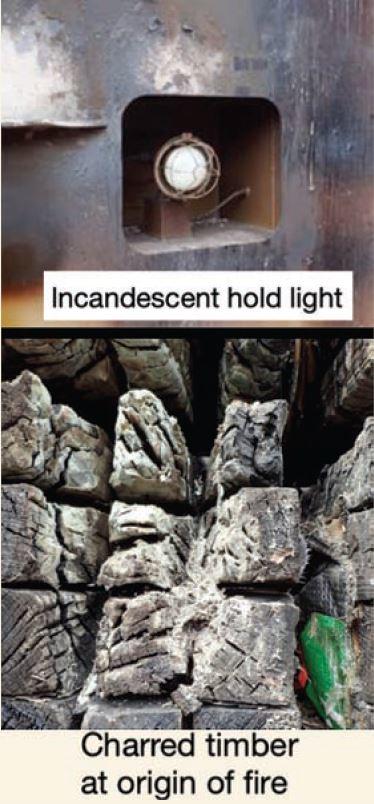201924 Incandescent cargo hold lights a hazard
Incandescent cargo hold lights a hazard
As edited from TAIC (New Zealand) report MO-2017-205
A general cargo ship was in port loading timber packs, machinery and containers. Once the holds were loaded with the timber pack cargo, the stevedores loaded machinery on the main deck. Finally, dangerous goods containers were loaded on top of number four hatch cover. The deck cargo was then lashed secure for sea.
About 90 minutes later the number four cargo hold smoke detection alarm sounded throughout the crew accommodation. When the access hatch to number four cargo hold was lifted a burning smell was detected.The general alarm was activated to summon any crew who had not already mustered on rst hearing the smoke alarm.
The ship’s crew began to prepare the firefighting equipment and the re team returned to the access hatch and prepared to enter number four cargo hold. This time when the access hatch was opened, smoke could clearly be seen coming from the cargo hold. The first fire team entered the cargo hold with the intention of locating and fighting the fire. They soon found thattheir access was blocked by containers and that visibility was limited due to heavy smoke, so they exited.
The port authorities were advised and assistance from the local fire service was requested. Once all crew members were accounted for and the cargo hold sealed, 48 bottles of CO2 were released into the hold. Boundary cooling now took place and the temperature on the bulkheads of number four cargo hold was monitored. Some time later it was decided to release the remaining 24 bottles of CO2 into the hold and discharge the dangerous goods containers on the hatch.
About four hours later the incident management team, made up of vessel and shore personnel, agreed to open the hold. No smoke was present inthe hold and the fire appeared to have been extinguished. Some of the findings of the official report were:
● The fire was caused by heat radiating from an incandescent cargo hold lamp. The lamp set fire to packs of timber that had been stowed within 45–50mm of the lamp.
● The ship had no written procedure or checklist for ensuring the cargo hold lights were switched off before flammable cargo was loaded against cargo light recesses, or when loading was complete and hatch lids were closed.

Lessons learned
- For a fire in a cargo hold, fixed CO2 is usually your best option.
- Release, wait and boundary-cool. Monitor temperatures and do not open hatches too soon.
- The responsibilities of command structure when shore firefighters are on board should be clearly documented and understood by the various authorities involved in responding to the fire.
- High-temperature-producing cargo lamps are inherently more risky than LED lamps, which are now available at affordable prices.
